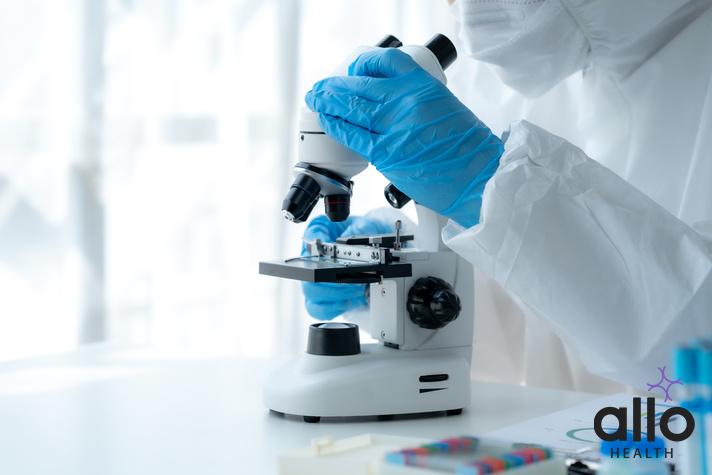How Is Lymphgranuloma Venereum (LGV) Diagnosed?

Allo Health is dedicated to personalized well-being, offering support and trusted information tailored to individual health goals. The platform emphasizes human-generated content, led by a distinguished medical team of experts, including physicians and sexual health specialists. Their commitment to credibility involves rigorous fact-checking, authoritative research, and continuous updates to ensure accurate, up-to-date information. Allo Health's unique approach goes beyond conventional platforms, providing expert-led insights and a continuous commitment to excellence, with user feedback playing a crucial role in shaping the platform's authoritative voice.

Dr Thanushree, has her MBBS from Kanachur Institute of Medical Sciences, Mangalore
Why This Was Upated?
Our experts continually monitor the health and wellness space, and we update our articles when new information became available.
Updated on 26 February, 2025
- Article was updated as part of our commitment to diversity, equity, and inclusion.
"The following blog article provides general information and insights on various topics. However, it is important to note that the information presented is not intended as professional advice in any specific field or area. The content of this blog is for general educational and informational purposes only.
Book consultation
The content should not be interpreted as endorsement, recommendation, or guarantee of any product, service, or information mentioned. Readers are solely responsible for the decisions and actions they take based on the information provided in this blog. It is essential to exercise individual judgment, critical thinking, and personal responsibility when applying or implementing any information or suggestions discussed in the blog."
Lymphogranuloma venereum (LGV), caused by specific strains of Chlamydia trachomatis, poses diagnostic challenges due to its varied symptoms and potential complications. In this exhaustive guide, we embark on a journey through the intricate diagnostic pathways of LGV, elucidating the methods, technologies, and considerations involved in identifying and confirming cases of this sexually transmitted infection (STI).
Introduction to LGV Diagnosis
LGV diagnosis encompasses a range of clinical, laboratory, and imaging techniques aimed at accurately identifying the presence of Chlamydia trachomatis serovars L1, L2, or L3. Given the diverse manifestations of LGV, a comprehensive approach is essential for timely intervention and effective management.
Clinical Evaluation
The diagnostic journey begins with a thorough clinical evaluation, where healthcare providers meticulously assess the patient’s medical history and perform a detailed physical examination.
- Medical History: Comprehensive inquiries into symptoms, sexual history, recent travel, and previous STI diagnoses provide valuable insights into potential LGV exposure and risk factors.
- Physical Examination: A meticulous physical examination focuses on identifying characteristic signs of LGV, including genital ulcers, inguinal lymphadenopathy, and rectal lesions. Careful palpation of the groin area aids in detecting swollen lymph nodes, a hallmark feature of LGV.
Laboratory Tests

Laboratory testing plays a pivotal role in confirming the diagnosis of LGV, with various methods available to detect the presence of Chlamydia trachomatis and assess disease severity.
- Nucleic Acid Amplification Tests (NAATs):
- Widely regarded as the gold standard for LGV diagnosis, NAATs detect Chlamydia trachomatis DNA in samples collected from affected sites.
- Genital, rectal, or lymph node specimens are collected via swabs or aspirates and subjected to NAATs, offering exceptional sensitivity and specificity in detecting LGV.
- Culture Tests:
- Despite declining utilization, culture tests remain a valuable diagnostic tool, particularly in cases where NAAT results are inconclusive.
- Culturing Chlamydia trachomatis involves growing the bacterium in specialized media under controlled conditions, facilitating bacterial isolation and identification.
- Direct Immunofluorescence Assay (DFA):
- DFA enables the direct visualization of Chlamydia trachomatis antigens in clinical specimens, providing rapid results for LGV diagnosis.
- While less sensitive than NAATs, DFA serves as a supplementary diagnostic tool, especially in resource-limited settings.
- Serologic Tests:
- Serologic assays detect LGV-specific antibodies produced by the immune system in response to infection. However, their utility is primarily limited to epidemiological studies and retrospective analyses due to the delayed antibody response.
Imaging Studies
In cases of suspected LGV complications or dissemination, imaging studies offer valuable insights into disease extent and severity.
- Ultrasound: Inguinal lymphadenopathy, a hallmark feature of LGV, is often evaluated using ultrasound imaging. This non-invasive modality provides detailed visualization of lymph node morphology and aids in assessing the presence of abscesses or fistulas.
- Computed Tomography (CT) Scan and Magnetic Resonance Imaging (MRI):
Differential Diagnosis

Distinguishing LGV from other STIs and non-STI conditions is paramount to ensuring appropriate treatment and management strategies.
- Other STIs: LGV shares clinical features with various STIs, including genital herpes, syphilis, and non-LGV chlamydia. Differential diagnosis relies on a combination of clinical findings, laboratory tests, and epidemiological considerations.
- Non-STI Conditions: Inflammatory bowel diseases, autoimmune disorders, and neoplastic processes may mimic LGV symptoms, necessitating comprehensive evaluations to rule out alternative diagnoses.
Diagnosing lymphogranuloma venereum (LGV) demands a multifaceted approach integrating clinical evaluation, laboratory tests, and imaging studies. Early detection and accurate diagnosis are pivotal in initiating timely treatment and preventing disease progression and complications. By leveraging advanced diagnostic technologies and fostering interdisciplinary collaborations, healthcare providers can effectively navigate the diagnostic challenges posed by LGV and optimize patient outcomes. Through continued research, education, and public health initiatives, we can enhance LGV detection capabilities and mitigate its impact on individual and community health.








































